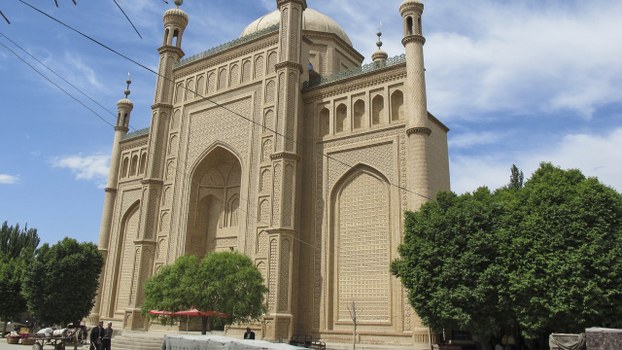Authorities in Atush (in Chinese, Atushi) city, in northwest China’s Xinjiang Uyghur Autonomous Region (XUAR), have razed two of three mosques in the village of Suntagh, according to a local security officer, amid a campaign that has seen thousands of Muslim holy sites destroyed in recent years.
The razing of the Azna and Bastaggam mosques in Suntagh is the latest to be confirmed since authorities began demolishing mosques in the XUAR en masse in late 2016, as part of a campaign known as “Mosque Rectification.”
The Mosque Rectification drive, part of a series of hardline policies under top leader Xi Jinping, predates the mass incarceration of as many as 1.8 million Uyghurs and other Muslim minorities in a vast network of internment camps in the XUAR that began in April 2017.
Through early investigations into the mosque campaign, RFA’s Uyghur Service found that authorities had destroyed some 70 percent of the mosques across the region. At the time, authorities gave “social safety” as the reason for the campaign, which appears to have continued into the years following 2016 and the intensification of the authorities’ comprehensive repression of Uyghurs.
RFA recently conducted a telephone interview with a Uyghur public security officer from Suntagh village in Atush, a county-level city of about 270,000 people under the administration of Kashgar prefecture in the cotton- and grape-growing region of southwestern XUAR.
A comparison shows satellite imagery of the Atush Eshtachi Grand Mosque in Xinjiang’s Atush city taken on Oct. 8, 2016 and Sept. 8, 2018. Uyghurism.com

The officer, who spoke on condition of anonymity for fear of reprisal, confirmed that two of three remaining mosques in the village were torn down in or around the autumn of 2019, and that the mosque authorities left standing was the smallest and in the poorest condition of all three.
“Azna mosque … was demolished last year,” the officer said, adding that he had observed the razing. “I think it was maybe in the fall … They brought machinery in for the demolition.”
“Suntagh’s Azna and Bastaggam mosques were destroyed … [Bastaggam] was demolished at the same time [as Azna],” he said, without providing a reason for the teardowns.
According to the officer, the local government decided to leave the third mosque—Teres mosque—standing, despite the fact that “the others were in better condition,” and far larger, and Bastaggam was conveniently situated next to the Suntagh bazaar.
Additionally, Azna and Bastaggam had been constructed by brick, he said, while Teres “has earthen walls” that are “covered with older wood.”
“[The destroyed] mosques were more solid because the roofs were poured … with cement,” while the wooden roof on Teres can barely keep out the rain, the officer said.
A comparison shows satellite imagery of the Atush Bastaggam Mosque in Xinjiang’s Atush city taken on Nov. 14, 2016 and in 2019. Uyghurism.com
Thousands razed
Tang dynasty China first encountered Islam in the seventh century, more than 1,000 years before the Qing dynasty settled what is now Xinjiang. China is now home to more than 22 million Muslims, including some 11 million Uyghurs. Mosques and other religious sites in Xinjiang were badly damaged during the political upheaval of China’s 1966-76 Cultural Revolution.
Since 2016, the Chinese authorities have been systematically destroying mosques, cemeteries, and other religious structures and sites across the XUAR.
An investigation by Agence France-Presse revealed that at least 45 cemeteries in the XUAR had been destroyed from 2014 until last October, with 30 razed since 2017. The sites were turned into parks or parking lots, or remained empty lots.
Last year, the Washington-based Uyghur Human Rights Project (UHRP) published a report detailing this campaign, titled “Demolishing Faith: The Destruction and Desecration of Uyghurs Mosques and Shrines,” which uses geolocation and other techniques to show that anywhere between 10,000 and 15,000 mosques, shrines, and other religious sites in the region were destroyed between 2016 and 2019.
In some cases, only the domes and towers were removed from certain structures, while in others, characteristically Islamic elements such as stars and crescents, domes, and scripture plaques were erased. In some cases, entire mosques have also been felled.
A comparison shows satellite imagery of the Atush Suntagh Mosque in Xinjiang’s Atush city taken on Nov. 14, 2016 and May 10, 2019. Uyghurism.com

China has offered no official response to the report or to claims about the large-scale and widespread destruction it has undertaken. However, Chinese authorities have continued to bring international visitors to mosques such as Id Kah in Kashgar, as well as to other religious sites around the region, and to publish articles depicting the mosque in state-run media, all in support of the official line that Uyghurs enjoy religious freedom in the region.
In spite of satellite imagery that proves a number of mosques have been destroyed, Chinese authorities continue to deny the large-scale demolitions in an attempt to hide the scale of destruction from the international community.
Recently, a spokesperson for China’s Ministry of Foreign Affairs pointed out in an official statement that there are more mosques in the XUAR than in all of the United States. Additionally, the Chinese Embassy in Ankara, Turkey, issued a statement claiming that there is one mosque for every 500 people in the Uyghur Region.
However, it remains clear from a variety of other sources that the authorities have destroyed mosques across the region, leaving single mosques standing in many communities where there used to be dozens.
Analysts have speculated that authorities have selectively left some mosques standing in the XUAR for show, rather than to allow local residents the freedom to practice religion.
Reported by Shohret Hoshur for RFA’s Uyghur Service. Translated by Elise Anderson. Written in English by Joshua Lipes.

